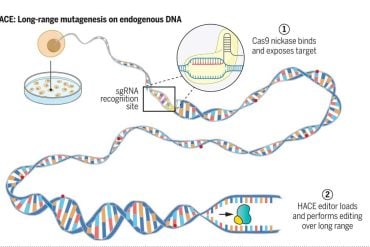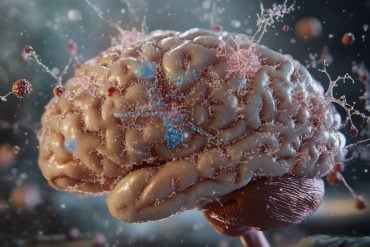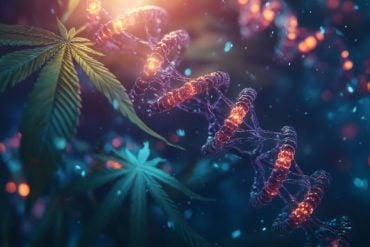Summary: Transgenic three-banded panther worms are helping researchers uncover vital clues about regeneration.
Source: Harvard
Cut off the head of a three-banded panther worm and another will take its place — mouth, brain, and all. Cut off its tail and it will grow another. Cut the worm in three separate pieces and within eight weeks there’ll be three fully formed worms. Cut it in … well, you get picture…
Put simply: Three-banded panther worms are one of the greatest of all time when it comes to whole-body regeneration. It’s why scientists started studying this Tic Tac sized worm in order to learn how it pulls off this amazing feat. Now, a team of researchers is taking the study of these worms to the next level by making them glow in the dark.
The work is described in a new paper in Developmental Cell and is led by Mansi Srivastava, a professor of organismic and evolutionary biology at Harvard who first collected these worms in 2010 to use as a model organism.
Now, worms that glow in the dark with UV light may sound gimmicky, but the researchers of the study explain it’s far from it.
The scientific way to say this is that the worms are now transgenic. Transgenesis is when scientists introduce something into the genome of an organism that is not normally part of that genome. “It’s a tool that biologists use to study how cells or tissues work within the body of an animal,” Srivastava said.
The glow in the dark factor comes from the introduction of a gene that, when it becomes a protein, gives off certain florescent glows. These fluorescent proteins either glow green or red and can lead to glowing muscle cells or glowing skin cells, for example.
What this glow up then allows is an ability to visualize with much better detail what the cells look like, where they are in the animal, and how they interact with each other.
Researchers are also able to add or takeaway specific information to the genome of the worm. This level of precision — when it comes to both visual resolution of the cells and ability to add to the genome or even tweak it how they want — is what makes transgenesis particularly powerful. It allows the researchers to study the specific mechanism of any process in an organism.
In the case of three-banded panther worms, a marine animal scientifically known as an acoel worm named Hofstenia miamia, researchers can do very precise manipulations, such as switching off certain genes. This could likely force the worm into some mistakes when it comes to regeneration, like growing a tail instead of a head or two heads instead of one and in the wrong place. This can ultimately help scientists truly narrow down what genes are required for the worm to carry out its usually perfect whole-body regeneration.
Now, with the ability to make transgenic worms, the researchers say they are most excited to study a population of stem cells critical to regeneration. The cells are called neoblasts and are believed to be pluripotent, meaning they can produce any other cell type in the animal, such as neurons, skin cells, muscle cells, or gut cells.
“We don’t know how any one of these cells actually behave in the animal during regeneration,” Srivastava said. “Having the transgenic worms will allow us to watch the cells in the context of the animal as it regenerates.”
Already, transgenesis in these worms has allowed the scientists to gain some novel biological insights with how the muscles fibers in the worm connect to each other and to other cells, such as those in the skin and the gut. The researchers saw muscle cells have extensions that interlock in tight columns and keep a closely-knit grid that gives the worm structure and support, almost like a skeleton.
The researchers are interested in knowing next whether the muscles are doing more than just holding things together, but are also storing and communicating information on what needs to be regenerated.

Making a transgenic worm line takes about eight weeks and the Srivastava lab has the steps down packed. They inject modified DNA into embryos that have just been fertilized. That DNA and its modifications then gets incorporated into the genome of the cells as they divide. When that worm grows it will be glowing and that glow will be passed along to its children and their children.
Srivastava has been studying these worms for a decade since she collected 120 of them in Bermuda when she was a postdoctoral researcher at the Whitehead Institute. In 2015, she joined the Harvard Department of Organismic and Evolutionary Biology, and launched a research program focused on studying regeneration and stem cells in panther worms. In a 2019 study, Srivastava and her colleagues uncovered a number of DNA switches that appear to control genes for whole-body regeneration in the worms.
Studying the worms for so long Srivastava and her team have grown quite attached to them, their striped patterns, and their intriguing behavior – from how they mate to being quite voracious predators, even cannibals on occasion. For instance, if they haven’t been fed in a while and there’s a few in a tank together they will take bites out of each other. Regeneration really comes in handy then, but if there’s a much bigger worm in there, some have been known to swallow smaller worms whole.
All that considered: “They’re absolutely charming,” Srivastava said. “They’re beautiful organisms.”
About this genetics and regeneration research news
Author: Juan Siliezar
Source: Harvard
Contact: Juan Siliezar – Harvard
Image: The image is credited to Lorenzo Ricci
Original Research: Closed access.
“Transgenesis in the acoel worm Hofstenia miamia” by Mansi Srivastava and Lorenzo Ricci. Developmental Cell
Abstract
Transgenesis in the acoel worm Hofstenia miamia
The acoel worm Hofstenia miamia, which can replace tissue lost to injury via differentiation of a population of stem cells, has emerged as a new research organism for studying regeneration.
To enhance the depth of mechanistic studies in this system, we devised a protocol for microinjection into embryonic cells that resulted in stable transgene integration into the genome and generated animals with tissue-specific fluorescent transgene expression in epidermis, gut, and muscle.
We demonstrate that transgenic Hofstenia are amenable to the isolation of specific cell types, investigations of regeneration, tracking of photoconverted molecules, and live imaging. Further, our stable transgenic lines revealed insights into the biology of Hofstenia, including a high-resolution three-dimensional view of cell morphology and the organization of muscle as a cellular scaffold for other tissues.
Our work positions Hofstenia as a powerful system with multiple toolkits for mechanistic investigations of development, whole-body regeneration, and stem cell biology.






